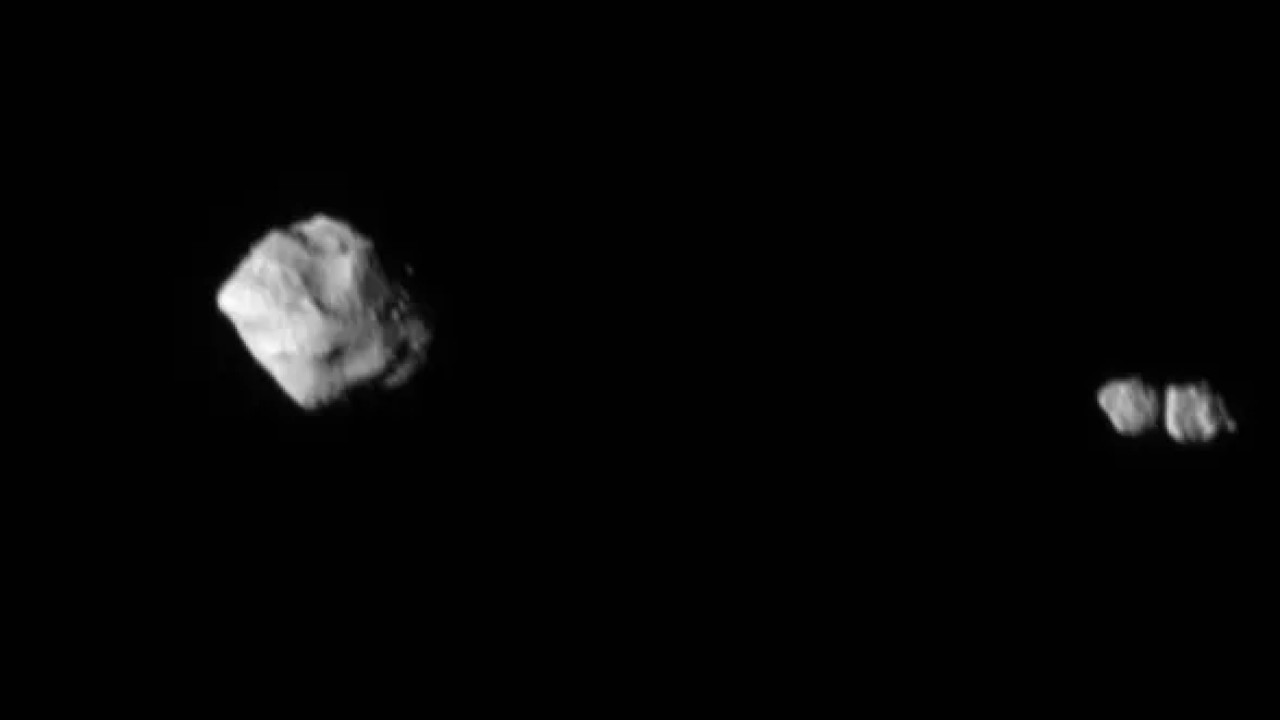NASA's Lucy asteroid-hopping spacecraft pins down surface ages of 1st asteroid targets
"In this small system, we are seeing incredibly complex processes that are happening."

Last November, when NASA's Lucy spacecraft flew past its first official asteroid target named Dinkinesh, it found the space rock was not one, not two but three rocks huddled together. While scientists were surprised to spot Selam, Dinkinesh's natural satellite, they were shocked to discover that Selam itself was, in fact, two objects melded together.
Dinkinesh (Amharic for "marvelous") was randomly selected as an engineering test for Lucy's terminal tracking system that allows the spacecraft to autonomously pinpoint an asteroid's location and keep it within its field of view. Scientists said they had conservative requirements for the probe's stability.
"We totally blew those requirements out of the water," said John Spencer, the mission's deputy project scientist at the Southwest Research Institute (SwRI) in Texas. "We had pin sharp images all the way through the encounter."
Related: Curious double moon discovered orbiting asteroid 'Dinky' now has a name
"It worked so much better than we expected just in about every way," added Hal Levison, the mission's principal investigator at SwRI.
Earlier this month, Spencer, Levison and other mission members shared with scientists preliminary results from that fortuitous encounter, which resulted in a wealth of data. Speaking at the Lunar and Planetary Science Conference (LSPC) in Texas, they said Dinkinesh and Selam appear to be roughly the same age, have similar ridges on their equators — suggesting mass shedding and re-accretion — and are mildly battered with impacts that left behind detectable craters. Unsurprisingly, the space rocks are also likely to be fragments of larger rocks, said Simone Marchi, the deputy principal investigator of the mission at SwRI.
"It's basically unavoidable," he said. Objects larger than 62 miles (100 kilometers) are more likely to be primordial objects while those smaller are very likely to be ones destroyed by collisions over time, he said. Dinkinesh is a mere 0.5 miles (790 meters) while each lobe on Selam is 0.15 miles (220 meters) wide, so "by necessity it must be a fragment of larger objects."
Get the Space.com Newsletter
Breaking space news, the latest updates on rocket launches, skywatching events and more!
From the larger craters present on the space rocks, scientists have inferred Dinkinesh to be 7 million years old and Selam about 2 million years old. They say it is intriguing that Dinkinesh and Selam do not have a large age difference (cosmically speaking, 5 million years is a breeze compared to our 4.5-billion-year-old solar system).
"This could tell us something fundamental about the formation of these objects and possibly different processes are responsible for Dinkinesh and Selam," said Marchi.
Selam's two lobes rest on one another, confirming their contact-binary nature, but their apparently thin boundary remained in shadow throughout Lucy's brief encounter. "It is a very, very weak rock," Marchi said of Selam.
Many of the features scientists see on the asteroids' surfaces can be explained by the "YORP effect," which occurs when an asteroid absorbs some sunlight and re-emits that energy as radiation, which then produces a slight thrust that spins up the space rock. Ridges visible on the equators of Dimorphos and Didymos, for instance, are thought to be accretions of material built up after that material was shedded during such a spin up.
"In this small system, we are seeing incredibly complex processes that are happening," said Edward Bierhaus of Lockheed Martin in Colorado.
The Lucy mission, which launched in October 2021, will begin touring its list of primary targets, the Trojan asteroids, starting August 2027. These Trojan asteroids glide in two swarms ahead and behind Jupiter's orbit around the sun. From 2027 to 2033, Lucy will study eight Trojan asteroids, from which scientists hope to gather clues about the creation of our solar system and perhaps the genesis of life on Earth.
Until then, scientists back home will no doubt be busy studying Lucy's data of the serendipitously discovered Dinkinesh system, trying to put together the story of its formation and evolution.
"The fact that this random object turned out to be so interesting and so weird," said Keith Noll, project scientist at the NASA Goddard Space Flight Center in Maryland, "either we got incredibly lucky or there's just generally more complexity in these small asteroids than we thought."
Join our Space Forums to keep talking space on the latest missions, night sky and more! And if you have a news tip, correction or comment, let us know at: community@space.com.

Sharmila Kuthunur is a Seattle-based science journalist focusing on astronomy and space exploration. Her work has also appeared in Scientific American, Astronomy and Live Science, among other publications. She has earned a master's degree in journalism from Northeastern University in Boston. Follow her on BlueSky @skuthunur.bsky.social









